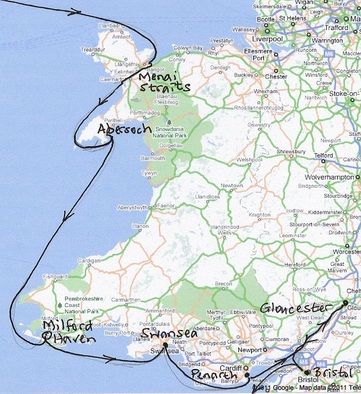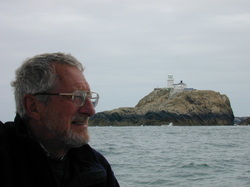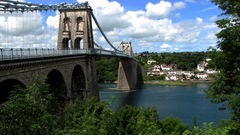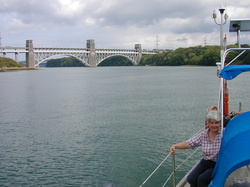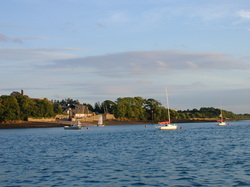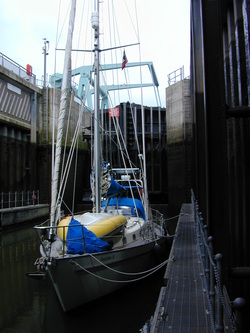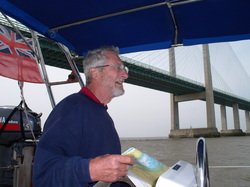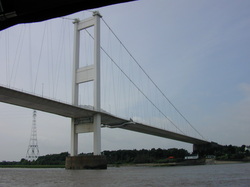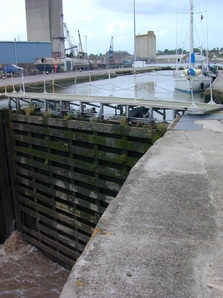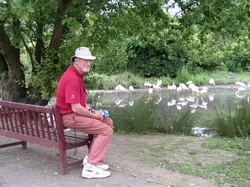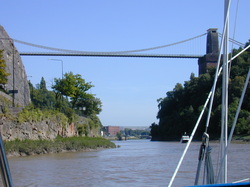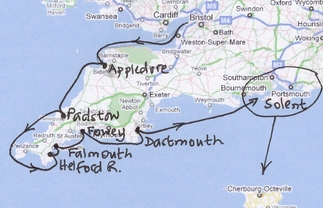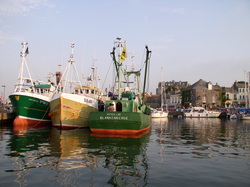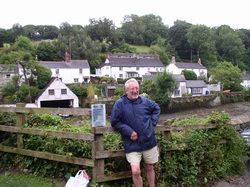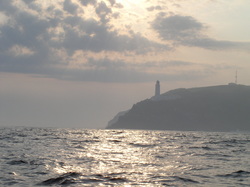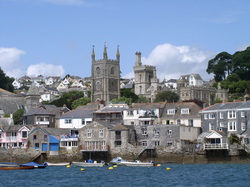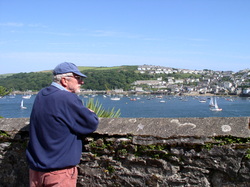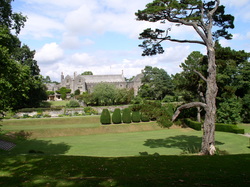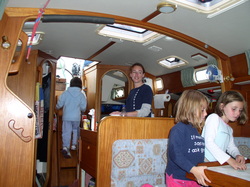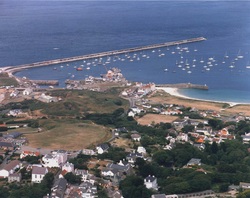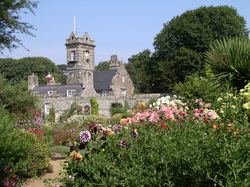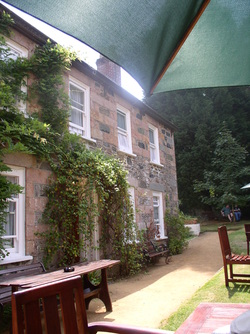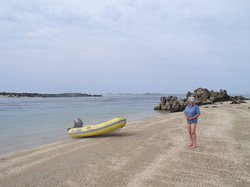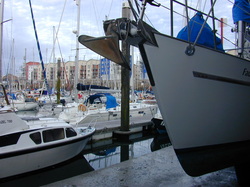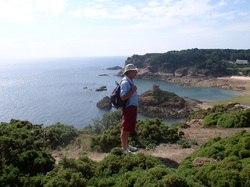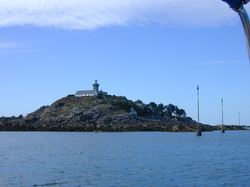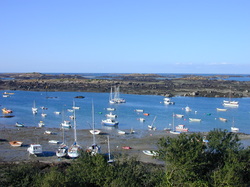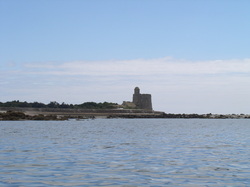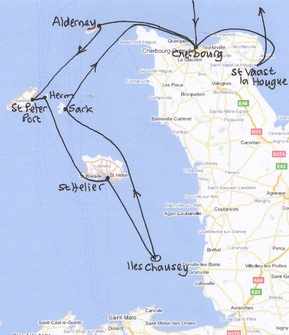2003 - Under seven bridges – and the English Channel revisited
|
U |
Up the River Severn to Gloucester and Bristol
The Severn won and so early next morning we set off to Swansea and locked in to spend the night in the splendid new marina there, doing our laundry and going to the cinema. Then on up the Severn, now having to take note of the sand banks, to the marina at Penarth (Cardiff) – again new, excellent and entered via a huge lock into the barrage. Friends came with their two children to visit and we took them for a sail for a mile or so across the barrage water to Cardiff where we had a Chinese dinner. Next day, 8 July, we sailed up-river in moderate visibility to pass under the Severn bridges, en route to the Sharpness canal and Gloucester. This was a high activity day. We contacted the Sharpness canal people who advised that arriving an hour before HW at the their lock would be ideal. Their HW is an hour after HW at the bridges, and it takes about an hour to travel from the bridges to the lock. I compromised and aimed to reach the bridges at HW-1½ (the bridge). I had been using a chart plotter until now (what a Godsend and how lazy they make you!) but I had no computer chart beyond the first bridge and I was back to the paper chart with GPS, eyeball and HB compass. The first bridge reached is properly called the Second Severn Crossing. It opened in 1996 and carries the M4. The second is the Severn Bridge - that one was opened 30 years earlier and carries the M48. The tidal stream swept us along at great speed under both the bridges. After the second one the channel does a sharp dogleg to port quite close to the shore, near where the old Severn ferry used to dock at Beachley, before it turns once again to head upstream. I missed the turn as I didn’t go to Port hard enough and we went right over the sand bank. However it didn’t matter, the water level was high and there was in fact ample depth – probably right across the river’s width. Nevertheless one tries to follow the proper route! It’s all adequately buoyed and there are some transits but you do have to look well ahead and be careful not to be swept off line. The mud makes the water a thick chocolate colour. (That was 5 bridges done). We reached the entrance to the Sharpness canal without incident and the dock master gave us clear instructions. They were locking a freighter out and we would then go in – and so it happened. It was all very easy but the dock’s walls were THICK with mud. We should have covered the fenders with black bin bags as it later took me some time to clean the mud off the fender socks. Once into the canal we paid the canal dues, which for us were £40 for in and out of the lock that we had come through and £23 for a week’s canal license - nothing else to pay for moorings etc. Two men then went off to open the huge swing railway bridge that crosses the canal about a mile from the lock beyond Sharpness docks. They did this very cheerfully, by hand, and after only a short delay we set off up the canal. It is 16 miles long, has 16 bridges, and it takes about 3 hours to reach Gloucester. It’s a really pleasant and restful 3 hours. The bridge opening is very good; as you go through one, the bridge master telephones the next one, so that generally they are ready for you and the bridge swings open as you arrive. Open Sesame! Most of the traffic is Narrow Boats. A 40 ft yacht is a rarity and we attracted more than the usual amount of interest and greetings. We moored alongside in Gloucester docks feeling very pleased with ourselves for having made it safely! Apart from the cathedral, where we spent a couple of hours being shown round, there is not too much to see in Gloucester but it was of general interest to me as I used to live not far away in my youth. However after lunch the next day we left and made our way back along the canal. It is very rural and pretty. You pass villages with their churches (some below canal level) and near to Sharpness the canal passes alongside the Severn, about a mile away, but probably 30 feet or so higher than it. In the late afternoon we moored by the canal edge with the keel stuck in the mud about a metre from the bank (no springs necessary) and had a pleasant evening with some Narrow Boaters that we had met earlier. It was a very quiet night. We watched grebes busy in the reeds and saw the occasional owl flying by. Tranquil. There are several places on the canal with a pub and a shop and next morning we stopped at one in order to visit the WWT Centre at Slimbridge. It’s only about a mile from the canal and gave us an interesting diversion for three hours. It was not the best time of the year to visit but there were enough birds of different varieties to make it worthwhile. We reached Sharpness by late lunchtime and were told that the lock would be opened for us at 1515. Our Narrow Boat friends were coming through too – they had booked a pilot to take them downstream to Portishead, our destination that day. We all locked out but the Narrow Boats didn’t leave, as the forecast wind of 20 kts against the tide was deemed unsafe for them. We had an uneventful trip downstream, although it was quite rough near the bridges. We made good speed with the gathering ebb under us and we reached and locked into the new marina at Portishead at 1945. Next day was my birthday (I seem to have one in every log I write!) and several telephone messages came in. We found the mobile phone endlessly useful and comforting and were very rarely out of signal range. We also used the Internet facilities found in all libraries (usually free), and we did so again here in Portishead. There is an excellent Waitrose near the marina and they agreed to deliver our supplies – a service that they hadn’t properly started at that time but intended to provide soon. We were happy to be a test case. We locked out after lunch with four Narrow Boats, including our two friends who had arrived in the early morning, and motored the two miles up the Severn to the entrance of the River Avon. |
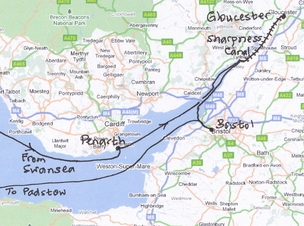
They had left the lock before us but we overtook them quite soon and led the way up the Avon towards Bristol. Here were our last two bridges; firstly the 1974 motorway bridge carrying the M5, and then as we approached Bristol, majestically and improbably, Brunel’s stunning 1864 Clifton Suspension bridge crossing some 73 metres above us. Shortly after that we reached the Cumberland basin with its lock into the Bristol ‘Floating Dock’ and a swing road bridge. (Incidentally there can be a rise of tide here of 9.4 metres!) We were quite quickly locked in but, because it was rush hour, they couldn’t open the swing bridge and stop the traffic until about 90 minutes later. The Narrow Boats went on. Once through we were lucky to get a space in the secure Bristol marina. Vandalism can be a problem elsewhere in the docks - we saw a small launch being jumped on and its canvas work damaged by some youths.
We spent the next day in Bristol and met my sister who lives fairly nearby. We visited the lovely St Mary’s Church, Redcliffe and inevitably went shopping in the city. Then next day, Sunday, we were up at 0500, locked out and made our way down to Avonmouth where we arrived at 0730, which was also HW. We carried the ebb down the Severn and by the time we passed between Flat Holm and Steep Holm islands we were travelling at over 12 knots across the ground. The navigation was not difficult (really at any stage) but it is really essential to know always where you are as the sand banks do lurk on either side and there is a tendency to get swept off one’s preferred line by the swirling tidal stream. At 1100 there was enough wind from the east to allow me to deploy the Cruising Chute and we held that until 1300 when the wind went round and came in strongly from the south. At 1630 we reached the Bideford FWB and made our way gingerly in through the channel that leads into Appledore where we took a spare RNLI mooring buoy. Again TG, as the tide passes through the harbour at great speed and we felt secure on the buoy in a way that would have been impossible with an anchor. We didn’t launch Buttercup because of the water’s speed and so, sadly, didn’t go ashore.
We spent the next day in Bristol and met my sister who lives fairly nearby. We visited the lovely St Mary’s Church, Redcliffe and inevitably went shopping in the city. Then next day, Sunday, we were up at 0500, locked out and made our way down to Avonmouth where we arrived at 0730, which was also HW. We carried the ebb down the Severn and by the time we passed between Flat Holm and Steep Holm islands we were travelling at over 12 knots across the ground. The navigation was not difficult (really at any stage) but it is really essential to know always where you are as the sand banks do lurk on either side and there is a tendency to get swept off one’s preferred line by the swirling tidal stream. At 1100 there was enough wind from the east to allow me to deploy the Cruising Chute and we held that until 1300 when the wind went round and came in strongly from the south. At 1630 we reached the Bideford FWB and made our way gingerly in through the channel that leads into Appledore where we took a spare RNLI mooring buoy. Again TG, as the tide passes through the harbour at great speed and we felt secure on the buoy in a way that would have been impossible with an anchor. We didn’t launch Buttercup because of the water’s speed and so, sadly, didn’t go ashore.
